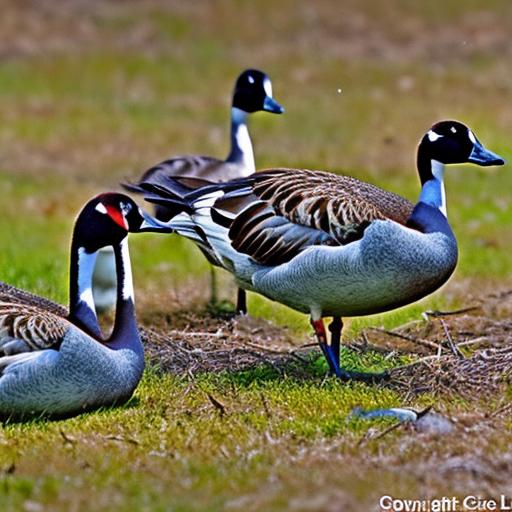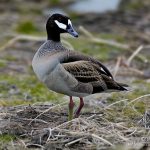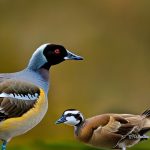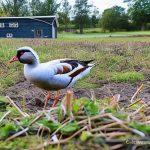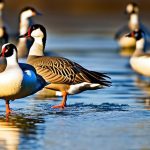Canada geese are a common sight in many parts of North America, including suburban neighborhoods and urban parks. While these majestic birds can be a delight to watch, they can also cause problems for homeowners. Canada geese are known for their aggressive behavior, especially during mating season, and their large flocks can leave behind a mess on lawns and other outdoor spaces. In this article, we will explore the behavior of Canada geese, the damage they can cause to lawns, and various methods to deter them from your property.
Key Takeaways
- Canada geese are social birds that mate for life and are highly protective of their young.
- Signs of Canada geese damage to your lawn include droppings, trampled grass, and feather debris.
- Natural deterrents for Canada geese include planting tall grasses, using decoys, and installing motion-activated sprinklers.
- Physical barriers like netting, fencing, and hedges can prevent Canada geese from accessing your lawn.
- Scare tactics like loud noises, predator decoys, and trained dogs can be effective in keeping Canada geese away.
Understanding Canada Geese Behavior
Canada geese are monogamous birds that mate for life. They typically begin breeding in their second or third year of life and will return to the same nesting site each year. During the breeding season, which usually occurs in the spring, Canada geese become territorial and may exhibit aggressive behavior towards humans or other animals that come too close to their nests.
In addition to their mating habits, Canada geese are also known for their migration patterns. They typically migrate south in the fall to warmer climates and return north in the spring to breed. However, some Canada geese have become non-migratory and will stay in one area year-round if they have access to food and water.
Canada geese are attracted to certain areas because they provide ideal conditions for nesting and feeding. Lawns with short grass are particularly attractive to Canada geese because they provide easy access to food and a clear view of potential predators. Bodies of water, such as ponds or lakes, are also attractive to Canada geese because they provide a source of food and a safe place to rest.
Identifying Canada Geese Damage to Your Lawn
One of the most common problems homeowners face with Canada geese is the damage they can cause to lawns. The primary issue is the accumulation of droppings, which can be unsightly and difficult to clean up. Canada geese can produce a significant amount of waste, and their droppings can quickly cover a lawn, making it unpleasant for homeowners and their guests.
In addition to droppings, Canada geese can also cause damage to lawns by trampling the grass. As they walk across a lawn in search of food, Canada geese can create bare patches or compact the soil, leading to thinning or dying grass. This can be particularly problematic for homeowners who take pride in maintaining a lush and healthy lawn.
The damage caused by Canada geese can be harmful not only to the appearance of the lawn but also to the environment. The excessive accumulation of droppings can lead to nutrient imbalances in the soil, which can affect the health of the grass and other plants. Additionally, the waste from Canada geese can contribute to water pollution if it washes into nearby bodies of water.
Natural Deterrents for Canada Geese
There are several natural deterrents that homeowners can use to discourage Canada geese from their lawns. One effective method is to plant certain types of vegetation that are unappealing to Canada geese. For example, tall grasses or shrubs with thorns can make it difficult for Canada geese to access the lawn and may deter them from landing.
Another natural deterrent is the use of decoys. Placing decoy predators, such as plastic owls or coyotes, on the lawn can create the illusion of danger and discourage Canada geese from landing. It is important to move the decoys regularly to prevent the geese from becoming accustomed to their presence.
While natural deterrents can be effective in some cases, they may not always provide a foolproof solution. Canada geese are adaptable birds and may become accustomed to certain deterrents over time. Therefore, it is important to combine natural deterrents with other methods for maximum effectiveness.
Physical Barriers to Keep Canada Geese Off Your Lawn
In addition to natural deterrents, physical barriers can also be used to keep Canada geese off your lawn. One common method is the use of netting or fencing. Netting can be installed over the lawn to prevent Canada geese from landing, while fencing can be used to create a physical barrier that prevents access to the lawn.
Netting is a relatively inexpensive and easy-to-install option for keeping Canada geese off your lawn. It can be attached to stakes or posts around the perimeter of the lawn and should be installed at a height that prevents the geese from flying over it. However, it is important to regularly check the netting for any damage or gaps that may allow the geese to enter.
Fencing is another effective option for keeping Canada geese off your lawn. A sturdy fence with small gaps between the slats can prevent the geese from accessing the lawn. However, it is important to choose a fence that is tall enough to prevent the geese from flying over it and to regularly inspect the fence for any damage or gaps.
Installing Fencing to Prevent Canada Geese from Entering
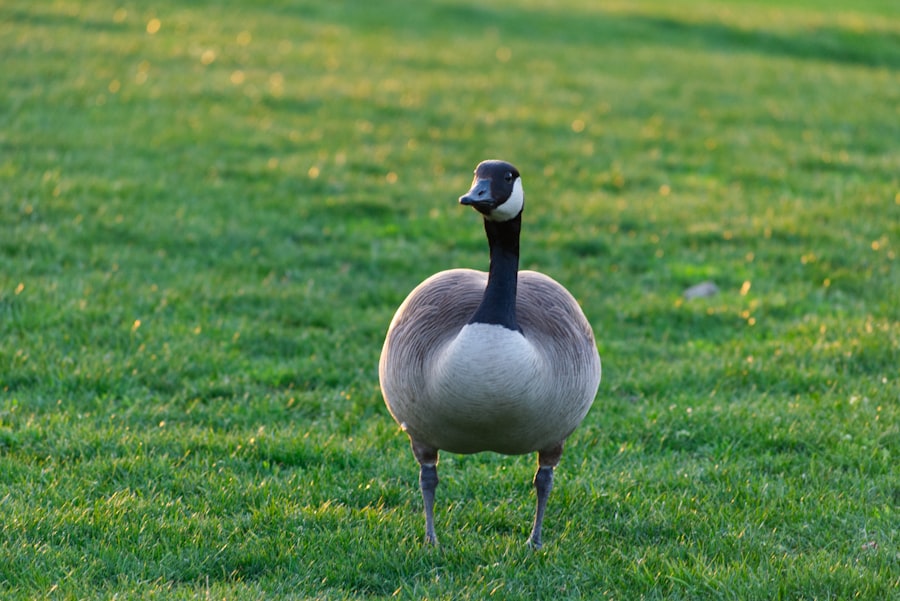
Installing fencing to prevent Canada geese from entering your lawn requires careful planning and consideration. The first step is to determine the size and layout of your lawn and decide where you want to install the fence. It is important to choose a location that will effectively deter Canada geese while still allowing access for maintenance and other activities.
Once you have determined the location of the fence, you will need to choose the right type of fencing material. There are several options available, including chain-link, vinyl, or wood. Each type of material has its own advantages and disadvantages, so it is important to consider factors such as durability, maintenance requirements, and aesthetic appeal when making your decision.
After selecting the fencing material, you will need to measure the perimeter of your lawn and purchase the necessary materials. It is important to ensure that you have enough fencing material to completely enclose the lawn and that you have all the necessary tools and hardware for installation.
The next step is to prepare the area for installation. This may involve clearing any vegetation or debris from the perimeter of the lawn and leveling the ground if necessary. It is also important to check for any underground utilities or obstacles that may interfere with the installation process.
Once the area is prepared, you can begin installing the fence. This may involve digging post holes, setting posts in concrete, and attaching the fencing material. It is important to follow the manufacturer’s instructions and take all necessary safety precautions during the installation process.
Scare Tactics to Keep Canada Geese Away
Scare tactics can be an effective way to keep Canada geese away from your lawn. One popular method is the use of noise makers, such as air horns or whistles. These devices can be used to startle the geese and discourage them from landing on your lawn.
Another scare tactic is the use of motion-activated sprinklers. These devices are equipped with sensors that detect movement and automatically spray water when triggered. The sudden burst of water can startle Canada geese and make them think twice about landing on your lawn.
It is important to note that scare tactics may not provide a long-term solution for keeping Canada geese away. The geese may become accustomed to certain scare tactics over time, rendering them ineffective. Therefore, it is important to combine scare tactics with other methods, such as physical barriers or repellents, for maximum effectiveness.
Using Repellents to Keep Canada Geese Off Your Lawn
Repellents can be an effective way to keep Canada geese off your lawn. There are two main types of repellents: taste repellents and scent repellents.
Taste repellents are applied directly to the grass and make it unappealing for Canada geese to feed. These repellents typically contain a bitter or spicy substance that is harmless to the geese but unpleasant to their taste buds. Taste repellents can be effective in deterring Canada geese from landing on your lawn and can be reapplied as needed.
Scent repellents work by emitting a strong odor that is unpleasant to Canada geese. These repellents typically contain natural ingredients, such as garlic or peppermint oil, that are safe for the environment. Scent repellents can be applied to the lawn or placed in strategic locations around the perimeter to create an unwelcoming environment for Canada geese.
It is important to note that repellents may need to be reapplied regularly, especially after rain or irrigation. Additionally, it is important to follow the manufacturer’s instructions and take all necessary safety precautions when using repellents.
Creating an Unwelcoming Environment for Canada Geese
Creating an unwelcoming environment for Canada geese can help deter them from your lawn. One effective method is to remove any food sources that may attract the geese. This may involve cleaning up fallen fruit or berries, securing garbage cans, and removing bird feeders or other sources of food.
Making changes to the landscape can also discourage Canada geese from visiting your lawn. For example, planting tall grasses or shrubs around the perimeter of the lawn can create a physical barrier that makes it difficult for the geese to access the area. Additionally, creating uneven terrain or installing rocks or gravel can make it less appealing for Canada geese to land.
It is important to note that creating an unwelcoming environment may require ongoing maintenance and monitoring. For example, tall grasses or shrubs may need to be trimmed regularly to prevent them from becoming overgrown and providing cover for the geese.
Seeking Professional Help to Manage Canada Geese
In some cases, it may be necessary to seek professional help to manage Canada geese. This is particularly true in cases where there is a large flock of geese or if the geese are exhibiting aggressive behavior.
When seeking professional help, it is important to choose a reputable company or individual with experience in Canada geese management. They should be knowledgeable about the behavior and habits of Canada geese and should be able to provide effective solutions for deterring them from your lawn.
It is also important to consider the methods used by the professional. Ideally, they should employ humane and environmentally friendly methods for managing Canada geese. This may include the use of non-lethal deterrents, such as noise makers or repellents, rather than resorting to lethal methods.
Maintaining a Clean and Tidy Lawn to Deter Canada Geese
Maintaining a clean and tidy lawn is an important step in deterring Canada geese. Regular mowing can help keep the grass short and make it less appealing for the geese to feed. Additionally, removing debris, such as fallen leaves or branches, can eliminate potential hiding spots for the geese.
It is also important to regularly clean up any droppings left behind by Canada geese. This can be done using a rake or shovel and should be done as soon as possible to prevent the waste from accumulating and causing damage to the lawn.
Regular maintenance of your lawn can also help prevent other issues that may attract Canada geese. For example, proper irrigation and drainage can prevent the formation of puddles or standing water, which can be attractive to the geese. Additionally, regular fertilization and weed control can help keep your lawn healthy and reduce the risk of damage from Canada geese.
In conclusion, Canada geese can cause problems for homeowners by damaging lawns and creating unsightly messes. Understanding their behavior and implementing effective deterrents can help manage Canada geese and keep them off your property. Whether you choose natural deterrents, physical barriers, scare tactics, or repellents, it is important to take action to protect your lawn and create an unwelcoming environment for Canada geese. By maintaining a clean and tidy lawn and seeking professional help when necessary, you can successfully manage Canada geese and enjoy a beautiful outdoor space.
If you’re looking for effective ways to keep Canada geese off your lawn, you may also be interested in learning about chicken coop interior ideas. Creating a well-designed and comfortable space for your chickens can not only enhance their overall well-being but also provide a natural deterrent for geese. Check out this article on poultrywizard.com to discover innovative ideas for maximizing the interior of your chicken coop. By implementing these strategies, you can create an environment that not only benefits your chickens but also helps keep unwanted visitors away from your lawn.
FAQs
What are Canada geese?
Canada geese are large water birds that are native to North America. They are known for their distinctive black heads and necks, white cheeks, and brown bodies.
Why do Canada geese come onto lawns?
Canada geese are attracted to lawns because they provide a source of food and water. They like to graze on grass and other vegetation, and they also like to drink from ponds and other bodies of water.
What problems can Canada geese cause on lawns?
Canada geese can cause a number of problems on lawns, including damage to grass and other vegetation, accumulation of droppings, and aggressive behavior towards humans and pets.
How can I keep Canada geese off my lawn?
There are several strategies you can use to keep Canada geese off your lawn, including installing physical barriers, using repellents, and modifying the landscape to make it less attractive to geese.
What are some physical barriers I can use to keep Canada geese off my lawn?
Physical barriers that can be effective at keeping Canada geese off your lawn include fences, netting, and scare devices like balloons or flags.
What types of repellents can I use to keep Canada geese off my lawn?
Repellents that can be effective at keeping Canada geese off your lawn include visual repellents like reflective tape or predator decoys, as well as auditory repellents like noise-making devices.
What are some landscape modifications I can make to keep Canada geese off my lawn?
Landscape modifications that can be effective at keeping Canada geese off your lawn include removing sources of food and water, planting unattractive vegetation, and creating barriers like ditches or berms.
Meet Walter, the feathered-friend fanatic of Florida! Nestled in the sunshine state, Walter struts through life with his feathered companions, clucking his way to happiness. With a coop that’s fancier than a five-star hotel, he’s the Don Juan of the chicken world. When he’s not teaching his hens to do the cha-cha, you’ll find him in a heated debate with his prized rooster, Sir Clucks-a-Lot. Walter’s poultry passion is no yolk; he’s the sunny-side-up guy you never knew you needed in your flock of friends!

